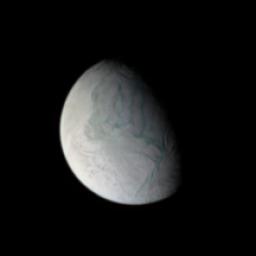
|
Icy Outpost?
- Click the image above for a larger view
- Full-Res JPEG (216 x 216) (2.8 kB)
- Full-Res TIFF (216 x 216) (140.3 kB)
Caption:
The Cassini spacecraft looks down under at the tortured south polar region of Enceladus, crossed by its "tiger stripes," or sulci, as the long, nearly parallel fractures are officially known. The use of enhanced color in this and other composite images makes the fractures and faults easier for the eye to detect.
The moon's excess warmth, water ice jets, and huge vapor plume laced with simple organic materials make it an excellent candidate for the search for pre-biotic chemistry, and possibly even life, beyond Earth.
Enceladus is 505 kilometers (314 miles) across.
This false-color view is a composite of images obtained using filters sensitive to ultraviolet, green and infrared light. The images were taken by the Cassini spacecraft narrow-angle camera on Jan. 16, 2007 at a distance of approximately 657,000 kilometers (408,000 miles) from Enceladus. Image scale is 4 kilometers (2 miles) per pixel.
Background Info:
The Cassini-Huygens mission is a cooperative project of NASA, the European Space Agency and the Italian Space Agency. The Jet Propulsion Laboratory, a division of the California Institute of Technology in Pasadena, manages the mission for NASA's Science Mission Directorate, Washington, D.C. The Cassini orbiter and its two onboard cameras were designed, developed and assembled at JPL. The imaging operations center is based at the Space Science Institute in Boulder, Colo.
For more information about the Cassini-Huygens mission visit http://saturn.jpl.nasa.gov/home/index.cfm . The Cassini imaging team homepage is at http://ciclops.org .
Cataloging Keywords:
| Name | Value | Additional Values |
|---|---|---|
| Target | Enceladus | |
| System | Saturn | |
| Target Type | Satellite | |
| Mission | Cassini-Huygens | |
| Instrument Host | Cassini Orbiter | |
| Host Type | Orbiter | |
| Instrument | Imaging Science Subsystem (ISS) | |
| Detector | Narrow Angle Camera | |
| Extra Keywords | Color, Infrared, Plume, Ultraviolet, Visual, Water | |
| Acquisition Date | ||
| Release Date | 2007-02-21 | |
| Date in Caption | 2007-01-16 | |
| Image Credit | NASA/JPL/Space Science Institute | |
| Source | photojournal.jpl.nasa.gov/catalog/PIA08881 | |
| Identifier | PIA08881 | |
